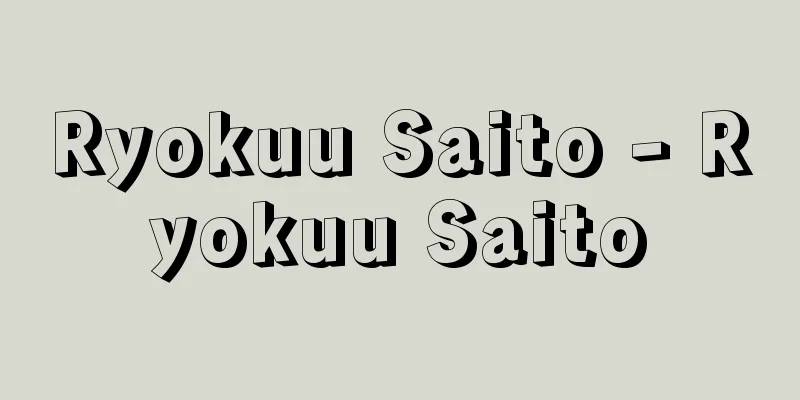Ryokuu Saito - Ryokuu Saito

|
Critic and novelist. Born on December 31, 1867, in Ise Kobe (Suzuka City, Mie Prefecture). His real name was Masaru. His aliases included Koto Midori, Shodayu, and Tosenbo. He dropped out of Meiji Law School (the precursor to Meiji University). He studied haiku under Kikakudo Eiki and novels under Kanagaki Robun. He started out with the Konnichi Shimbun, and then moved on to work in newspaper journalism for many publications, including the Tozai Shimbun, the Diet, the Niroku Shinpo, and the Yorozu Choho. He entered the literary world in 1889 (Meiji 22) with "Eight Schools of Novels," and thereafter displayed his talent for humorous criticism, mocking and ridiculing literary figures in works such as "A Guide to Novel Writing for Beginners," "Questions and Answers on Novel Criticism," and "Samples of New Style Poetry." In 1896, he published an anonymous joint critique with Mori Ogai and Koda Rohan titled "Three People's Jaugo" in the magazine "Mesamashigusa," and became renowned as "the highest authority on criticism" (Matsumoto Seicho). On the other hand, he established his position as a novelist with "Abura Jigoku" (1891), which depicts the tragedy of an innocent man's sexual training, and "Kakurenbo" (1891), which depicts a young man skillfully navigating the love affairs of the entertainment world. He also wrote "Kado Shamisen" (1895), but he was known more as a sharp and cynical satirist than as a talented novelist. His light-hearted writing and parody spirit stood out in the Meiji literary world, and his famous line was "It takes one pen to press something, but two chopsticks. You should know that you are no match for many." His other works include "Ama gaeru" (1897), "Ararezake" (1898), "Wasuregai" (1900), and "Midarebako" (1903). Died on April 13, 1904. [Ishizaki Hitoshi] "Complete Collection of Meiji Literature 28: The Collection of Saito Ryokuu" (1966, Chikuma Shobo)" ▽ "Saito Ryokuu by Masanari Hashizume" (1964, Kyushu Bungakusha) Source: Shogakukan Encyclopedia Nipponica About Encyclopedia Nipponica Information | Legend |
|
評論家、小説家。慶応(けいおう)3年12月31日、伊勢(いせ)神戸(かんべ)(三重県鈴鹿(すずか)市)の生まれ。本名賢(まさる)。別号江東みどり、正直正太夫(しょうだゆう)、登仙坊など。明治法律学校(明治大学の前身)中退。俳諧(はいかい)を其角堂(きかくどう)永機、小説を仮名垣魯文(かながきろぶん)に学ぶ。『今日(こんにち)新聞』を振り出しに、『東西新聞』『国会』『二六新報』『萬朝報(よろずちょうほう)』など多くの新聞ジャーナリズムを渡り歩く。1889年(明治22)『小説八宗』により文壇に登場、以後戯文批評に才筆を振るい、『初学小説心得』『小説評註(ひょうちゅう)問答』『新体詩見本』などで文壇人を揶揄嘲笑(やゆちょうしょう)し、さらに96年、森鴎外(おうがい)、幸田露伴と匿名合評『三人冗語(じょうご)』を雑誌『めさまし草』に掲載、「評壇最高の権威」(松本清張)として重きをなした。一方、うぶな男の色道修行の悲劇を描いた『油地獄』(1891)や、花柳界における恋のさや当てのなかを巧みに遊泳する青年を描いた『かくれんぼ』(1891)により小説家としての地位を確立、ほかに『門三味線』(1895)などがあるが、小説家としての才より辛辣(しんらつ)かつシニカルな風刺家として知られた。軽妙な文章とパロディー精神は明治文壇にあって異彩を放ち、「按(あん)ずるに筆は一本也(なり)、箸(はし)は二本也。衆寡敵せずと知るべし」は一代の名句。著書にはほかに『あま蛙(がえる)』(1897)、『あられ酒』(1898)、『わすれ貝』(1900)、『みだれ箱』(1903)などがある。明治37年4月13日没。 [石崎 等] 『『明治文学全集28 斎藤緑雨集』(1966・筑摩書房)』▽『橋爪政成著『斎藤緑雨』(1964・九州文学社)』 出典 小学館 日本大百科全書(ニッポニカ)日本大百科全書(ニッポニカ)について 情報 | 凡例 |
<<: Cytokinin - Saikainin (English spelling)
Recommend
Bâkî, Mahmud Abdülbâkî
Born: 1526. Istanbul Died: April 7, 1600. Court po...
Scilla sinensis (English spelling) Scilla sinensis
…[Yoshitaka Mizuno]. … *Some of the terminology t...
Theognis (English spelling)
A Greek elegiac poet active around 540 BCE. Born i...
Production date - Ikumusubi
…It is also written as production day or producti...
Safety valve - Anzenben (English) safety valve
A valve installed in equipment or piping that hand...
Pickles - Pickled vegetables
Pickles are made by fermenting or flavoring veget...
Nuchal septum - Nape
…The skin in this area is very thick, and hair gr...
Zrinyi Peter
…Today, he is considered one of the national acti...
Babst, IK (English spelling) BabstIK
...For this reason, their opponents, the Slavophi...
Mr. Toyoda
A medieval local feudal lord in Toyoda, Yamabe Cou...
Daimyoji Temple
Located on the central peak of Shugang in Yangzhou...
Caeciliidae
…They are ovoviviparous, and the larvae are devel...
Akanezumi (English name) Large Japanese field mouse
It is a member of the rodent family of mammals. I...
Gosho Heinosuke - Gosho Heinosuke
Film director. Born in Tokyo on February 1, 1902....
Class distribution - kyubunpu
...To do this, we organize the original table and...









